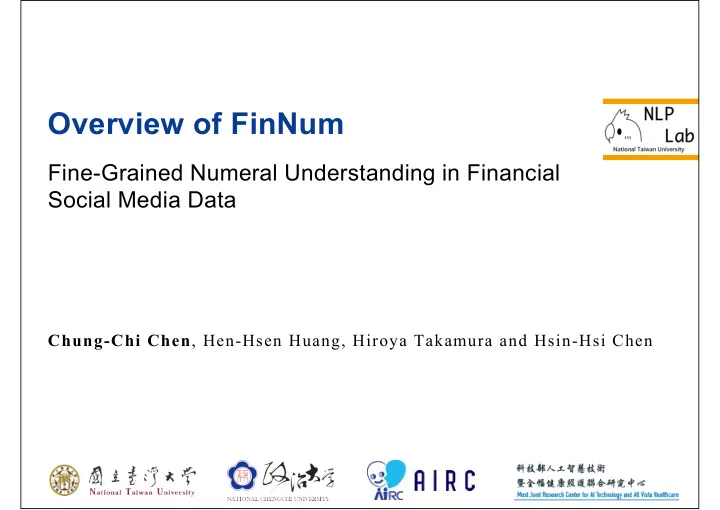

Overview of FinNum Fine-Grained Numeral Understanding in Financial Social Media Data Chung-Chi Chen , Hen-Hsen Huang, Hiroya Takamura and Hsin-Hsi Chen
Motivation 2
Numerals on Social Trading Platforms 3
Introduction $TSLA 256 Break-out thru 50 & 200 - DMA ( 197 - 230 ) upper head res ( 274 - 279 ) Short squeeze in progress Nr term obj: 310 Stop loss: 239 . 25 tokens 9 numbers 6 meanings We • propose fine-grained numeral taxonomy for financial social media data • attempt to leverage the numeral opinions made by the crowd to mine additional information for trading I will introduce the • application of proposed tasks • numeral taxonomy • details of FinNum shared task • empirical studies of extracted information • further research direction of the numerals in financial data • FinNum-2 proposal 4
Application Scenario 5
Crowd View: Converting Investors' Opinions into Indicators 6
Numeral Taxonomy 7
Numeral Taxonomy 8
Monetary • The Monetary category contains the following 8 subcategories: • “money”, “quote” and “change” • “buy price”, “sell price”, “forecast”, “stop loss” and “support or resistance” • The identification of “buy price” and “sell price” can help us understand the performance of the writer. • $SPY Long 1/2 position 137.89 • Some investors “forecast” the price of the instruments depending on their analysis results. • The concepts of support and resistance are always discussed in technical analysis. 9
Percentage • The numeral that indicates the proportion of a certain amount is classified into “absolute”. • The numeral that stands for the change relative to original amount is classified into “relative”. • ¢Den up almost 10 % since Q1 and £áuro up around 7.5%, much more $ for $AAPL pocket. Remember 23 % of Apple revenues comes from this two @jimcramer • 10% and 7.5% are annotated as “relative” • 23% stands for “absolute”. 10
Option • Option is a popular instrument frequently discussed. • To capture the implications of investors’ opinions, we propose two subcategories for Option category, “exercise price” and “maturity date”. • $XLU long April $ 44 calls • $MSFT those APR. 22 CALLS were getting hot. 11
Indicator • This category captures the parameters of the technical indicators. • Different investors may use dissimilar parameters for the same indicator. In order to capture the price most investors pay attention to, we should identify the parameters being used. • $ATHX riding 5 dma higher, dropping to 13 dma at the dips, sign of a healthy advancing stock that stays above 20 dma 12
Temporal • Temporal information is also important in financial domain. • The day most investor focusing on is the one with high volatility. • We classify Temporal category into two subcategories, “date” and “time” 13
Quantity • Quantity information can help us know the position of an investor, and we can give the large weighting to the opinions held by persons who have large positions. 14
Product/Version Number • The version of products may contain numerals. We can use the product information to compare importance of different tweets. • For example, the tweets discuss of iPhone 7 may be more important than the tweets that discuss iPhone 4. 15
Dataset 16
Corpus Creation • We collected the data from StockTwits. • Two experts were involved in the annotating process. • FinNum dataset contains only the numerals in full agreement. 17
Distribution 18
Task Setting 19
Task Formulation & Evaluation • The position of a numeral in a tweet is given in advance. • Participants are asked to disambiguate its category. • This task is further separated into two subtasks: • Classify a numeral into 7 categories, i.e., Monetary, Percentage, Option, Indicator, Temporal, Quantity and Product/Version Number. • Extend the classification task to the subcategory level, and classify numerals into 17 classes, including Indicator, Quantity, Product/Version Number, and all subcategories • Micro-averaged F-score and macro-averaged F-scores are adopted for evaluating the classification performance of participants' runs. 20
Participants 21
12 Teams including 15 Institutions from 6 Countries 武漢科技大學 22
Methods 23
Models 6/12 10:15-11:45 Session B-2 24
Results 25
Participants Results 6/12 10:15-11:45 Session B-2 26
Error Analysis Sell Stop Sup. Option Ind. Pro. 27
Empirical Study 28
Numeral Understanding in Financial Tweets for Fine-grained Crowd-based Forecasting 29
Crowd View: Converting Investors' Opinions into Indicators • The indicators related to the analysis results of crowd investors ( support and resistance price level) provide the incremental information for short-term ( 3- and 5-day ) trading. • The indicator constructed by the cost of crowd investors (buy-side and sell-side cost) furnish trader with additional long- term ( 10-day ) information. 30
Further Research Directions 31
Numeracy-600K: Learning Numeracy for Detecting Exaggerated Information in Market Comments • S&P 500 <.SPX> UP 1.53 POINTS, OR 0.08 PERCENT, AT AFTER MARKET OPEN • DOW JONES <.DJI> UP 8.70 POINTS, OR 0.05 PERCENT, AT AFTER MARKET OPEN • U.S. Q3 GDP rises pct 32
Multilingual & Different Domain & Document Level Clinical Geography Cooperation 33
Next Step 34
FinNum-2: Numeral Attachment • $NE OK NE, last time oil was over $65 you were close to $8. Giddy-up… • Given a target numeral and a cashtag, and we formulate the problem as a binary classification to tell if the given numeral is related to the given cashtag. • Macro-F1 score is adopted for evaluating the experimental results. • Baseline: CapsNet Macro-F1 score: 67.14% 35
Recommend
More recommend